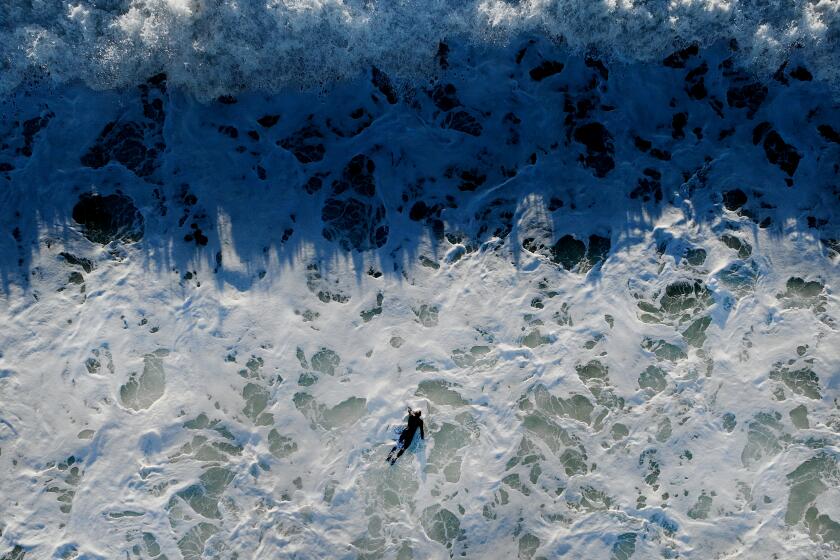Doc Strub Had a Racing Vision
When Santa Anita opened its doors on Christmas Day in 1934, it was widely considered an audacious, downright reckless idea.
It was the brainchild of a onetime minor league second baseman and a practicing credit dentist from San Francisco, Charles H. (Doc) Strub.
Doc Strub didn’t want to put his race track in Southern California. San Franciscans of the time considered anything south of the Tehachapis to be a citadel of bad taste, a community of boors, and--ugh!--movie people. The panners considered San Fran (don’t call me ‘Frisco) the hub of all West Coast activity. It looked down its nose at the south, which it felt wouldn’t even be settled if the railroad dicks did their job and intercepted the drifters en route. L.A. was simply one big hobo camp populated by drop-offs from a thousand freight trains.
But Doc Strub had to turn south. He couldn’t get the financing or the zoning variances in the haughty Bay Area.
He was warned. “If you build a track down there, those hicks’ll step around it to get at a wrestling match,” he was told.
But Doc Strub took his idea down to Southern California and, like a lot who came after him, made sports history.
He brought his idea first to the comedy producer, Hal Roach, who got his polo-playing friends in the movie industry to pony up a million dollars to subsidize Strub’s dream. Strub promptly sank the whole million in building racing’s Taj Mahal, a lordly complex in the lee of the Sierra Madre mountains, the most beautiful racing facility ever erected anywhere.
Doc Strub was so in hock by opening day, he had to borrow the money from a bank to book the bets, and the bank was so skeptical, it sent its armed guards to make sure the money was back by nightfall.
That’s the last time a bank had any misgivings about putting money in Santa Anita.
But Doc Strub wasn’t through. He next announced that his meet would be crowned by a $100,000 handicap. The racing establishment gasped.
You have to understand what $100,000 was that Depression year. Bread was a nickel, a gallon of gas was nine cents (except nobody had a car) and the song hits of the day were “Brother, Can You Spare A Dime?” and “Potatoes Are Cheaper (So Now’s The Time To Fall In Love),” sung by Eddie Cantor. A hundred grand for a horse race was the wildest kind of extravagance.
Doc Strub knew exactly what he was doing. He was putting his race track on the map, he was extracting priceless publicity, network radio and print--and he was attracting the best stock, human and equine, to his establishment. Not only did Twenty Grand and Equipoise and Discovery show up, so did the Whitneys and the Vanderbilts and the Astors.
Santa Anita always maintained its haughty attitude. It not only resisted the later exotic wagering (Pick Sixes and Trifectas) for a long time, it didn’t even have Daily Doubles. It tried to take what had been often a grifter’s, cheater’s sport and dignify it. The photo finish was first put into operation at Santa Anita, and the camera patrols of the races took a lot of larceny out of the cards. Santa Anita was not some border, riverfront scam parlor where they didn’t have races. They had scenarios.
Strub knew what the old-time movie moguls knew--if you made the surroundings as plush as a pasha’s palace, the public would come, if only to get away from their humdrum existence.
Strub also knew that, when you gave something away, its value became suspect. In an era when other tracks in other places gave away free passes by the bushel, Santa Anita not only charged admission, it charged for parking. It took the position you were privileged to be allowed in to bet your money. Some people went there just to spend the day. Strub didn’t care. It was the first track in America to admit children to its infield.
It became a model of a well-run sports enterprise. A unit of stock, once shopped up and down Hollywood Boulevard like a hot diamond, became a money tree for dozens of celebrity investors. Horses, particularly cheap horses, are the most inconsistent of God’s creatures, but Santa Anita, content with its 14%, strove to run an honest wheel.
Its Santa Anita Handicap became one of the world’s most celebrated horse races, and Doc Strub was the first to put in a grass track to lure the best European horses to his meets.
The jockey community was always the world’s best. Eastern riders who came out to match the Longdens, Shoemakers and Arcaros went home in a barrel.
The horses matched the men. Citation, Swaps, Seabiscuit, Affirmed, Round Table, Hill Prince and John Henry all raced here. Movies were made about them. The greatest horse race in history--at least in the view of storied trainer Sunny Jim Fitzsimmons--was staged here the day Citation and Noor hooked up in the longest stretch duel in the track’s history, in the San Juan Capistrano 1 3/4 miles in 1950. Noor won because Johnny Longden kept Citation’s jockey, Steve Brooks, pinned on the inside and unable to use his whip.
The Santa Anita Derby, once considered a laughingstock as a prep for the Kentucky Derby, has produced four of the last six Kentucky winners: Alysheba, Ferdinand, Winning Colors and Sunday Silence.
In an era of satellite wagering, state lotteries and the disappearing neighborhood bookie, Santa Anita still stands tall among American race tracks. It has $100,000 claiming races now. The parimutuel handle for the 1934-35 meet was $15,897,684. The figure for last year’s total handle was $643,706,659.
As Santa Anita opens its 55th meeting today, the sport is at a crossroads. It faces competition Doc Strub never dreamed of in ’34. When Santa Anita opened, there was no Las Vegas, no state lotteries, no Atlantic City. There really was no pro football nor pro basketball. No Dodgers, Angels, Rams, Raiders, Lakers. Its competition was Babe Ruth, Joe Louis and not much else.
So, should it join the national consensus and cut back? Well, horse racing is probably as close as you’ll get to a Depression-proof industry.
Doc Strub would probably build some more windows.
More to Read
Get our high school sports newsletter
Prep Rally is devoted to the SoCal high school sports experience, bringing you scores, stories and a behind-the-scenes look at what makes prep sports so popular.
You may occasionally receive promotional content from the Los Angeles Times.






